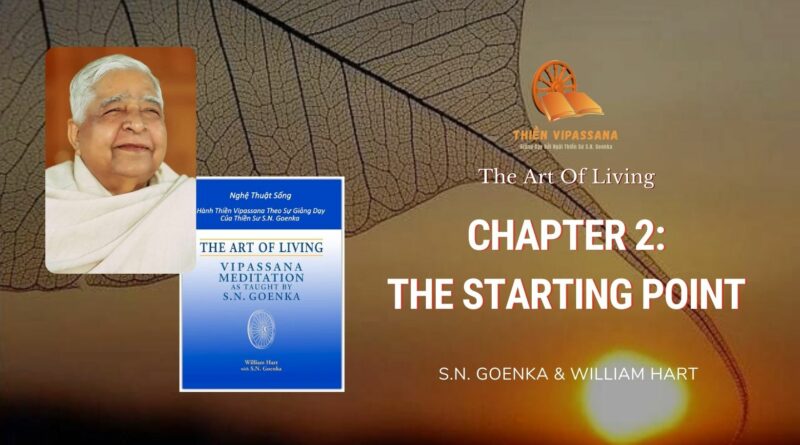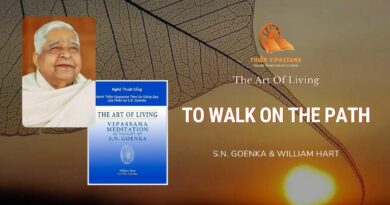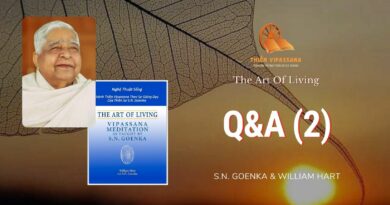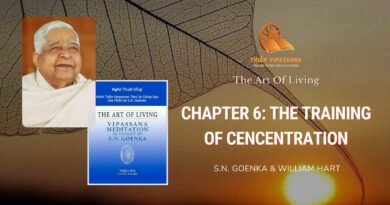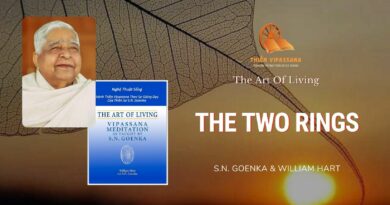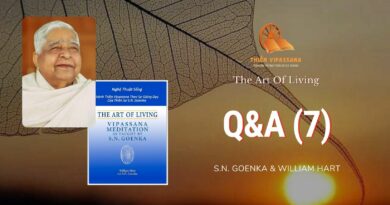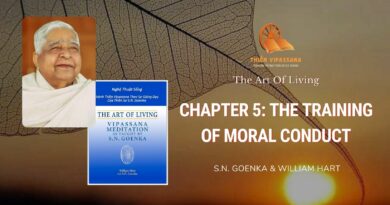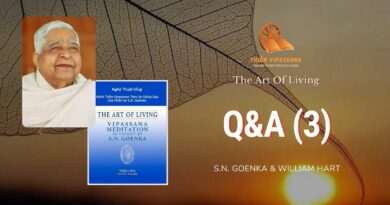Chapter 2. THE STARTING POINT
The source of suffering lies within each of us. When we understand our own reality, we shall recognize the solution to the problem of suffering. “Know thyself,” all wise persons have ad-vised. We must begin by knowing our own nature; otherwise we can never solve our own problems or the problems of the world.
But actually what do we know about ourselves? We are each convinced of the importance of ourselves, of the uniqueness of our-selves, but our knowledge of ourselves is only superficial. At deeper levels, we do not know ourselves at all.
The Buddha examined the phenomenon of a human being by examining his own nature. Laying aside all preconceptions, he ex-plored reality within and realized that every being is a composite of five processes, four of them mental and one physical.
Matter
Let us begin with the physical aspect. This is the most obvious, the most apparent portion of ourselves, readily perceived by all the senses. And yet how little we really know about it. Superficially one can control the body: it moves and acts according to the conscious will. But on another level, all the internal organs function beyond our control, without our knowledge. At a subtler level, we know nothing, experientially, of the incessant biochemical reactions occurring within each cell of the body. But this is still not the ultimate reality of the material phenomenon. Ultimately the seem-ingly solid body is composed of subatomic particles and empty space. What is more, even these subatomic particles have no real solidity; the existence span of one of them is much less than a tril-lionth of a second. Particles continuously arise and vanish, passing into and out of existence, like a flow of vibrations. This is the ultimate reality of the body, of all matter, discovered by the Buddha 2500 years ago.
Through their own investigations, modern scientists have rec-ognized and accepted this ultimate reality of the material universe.
However, these scientists have not become liberated, enlightened persons. Out of curiosity they have investigated the nature of the universe, using their intellects and relying on instruments to verify their theories. In contrast, the Buddha was motivated not simply by curiosity but rather by the wish to find a way out of suffering. He used no instrument in his investigation other than his own mind. The truth that he discovered was the result not of intellectualizing but of his own direct experience, and that is why it could liberate him.
He found that the entire material universe was composed of particles, called in Pāli kalāpas, or “indivisible units.” These units exhibit in endless variation the basic qualities of matter: mass, cohesion, temperature, and movement. They combine to form structures which seem to have some permanence. But actually these are all composed of minuscule kalāpas which are in a state of continuously arising and passing away. This is the ultimate reality of matter: a constant stream of waves or particles. This is the body which we each call “myself.”
Mind
Along with the physical process there is the psychic process, the mind. Although it cannot be touched or seen, it seems even more intimately connected with ourselves than our bodies: we may picture a future existence without the body, but we cannot imagine any such existence without the mind. Yet how little we know about the mind, and how little we are able to control it. How often it refuses to do what we want, and does what we do not want. Our control of the conscious mind is tenuous enough, but the unconscious seems totally beyond our power or understanding, filled with forces of which we may not approve or be aware.
As he examined the body, the Buddha also examined the mind and found that in broad, overall terms it consisted of four processes: consciousness (viññāṇa), perception (saññā), sensation (vedanā), and reaction (saṅkhāra).
The first process, consciousness, is the receiving part of the mind, the act of undifferentiated awareness or cognition. It simply registers the occurrence of any phenomenon, the reception of any input, physical or mental. It notes the raw data of experience without assigning labels or making value judgments.
The second mental process is perception, the act of recognition. This part of the mind identifies whatever has been noted by the consciousness. It distinguishes, labels, and categorizes the incoming raw data and makes evaluations, positive or negative.
The next part of the mind is sensation. Actually as soon as any input is received, sensation arises, a signal that something is hap-pening. So long as the input is not evaluated, the sensation remains neutral. But once a value is attached to the incoming data, the sen-sation becomes pleasant or unpleasant, depending on the evaluation given.
If the sensation is pleasant, a wish forms to prolong and intensify the experience. If it is an unpleasant sensation, the wish is to stop it, to push it away. The mind reacts with liking or disliking.1 For example, when the ear is functioning normally and one hears a sound, cognition is at work. When the sound is recognized as words, with positive or negative connotations, perception has started to function. Next sensation comes into play. If the words are praise, a pleasant sensation arises. If they are abuse, an unpleasant sensation arises. At once reaction takes place. If the sensation is pleasant, one starts liking it, wanting more words of praise. If the sensation is unpleasant, one starts disliking it, wanting to stop the abuse.
The same steps occur whenever any of the other senses receives an input: consciousness, perception, sensation, reaction. These four mental functions are even more fleeting than the ephemeral particles composing the material reality. Each moment that the senses come into contact with any object, the four mental processes occur with lightning-like rapidity and repeat themselves with each subsequent moment of contact. So rapidly does this occur, however, that one is unaware of what is happening. It is only when a particular reaction has been repeated over a longer period of time and has taken a pronounced, intensified form that awareness of it develops at the conscious level.
The most striking aspect of this description of a human being is not what it includes but what it omits. Whether we are Western or Eastern, whether Christian, Jewish, Muslim, Hindu, Buddhist, athe-ist, or anything else, each of us has a congenital assurance that there is an “I” somewhere within us, a continuing identity. We operate on the unthinking assumption that the person who existed ten years ago is essentially the same person who exists today, who will exist ten years from now, perhaps who will still exist in a future life after death. No matter what philosophies or theories or beliefs we hold as true, actually we each live our lives with the deep-rooted conviction, “I was, I am, I shall be.”
The Buddha challenged this instinctive assertion of identity. By doing so he was not expounding one more speculative view to combat the theories of others: he repeatedly emphasized that he was not putting forth an opinion, but simply describing the truth that he had experienced and that any ordinary person can experience. “The enlightened one has cast aside all theories,” he said, “for he has seen the reality of matter, sensation, perception, reaction, and consciousness, and their arising and passing away.”2 Despite appearances, he had found that each human being is in fact a series of separate but related events. Each event is the result of the preceding one and follows it without any interval. The unbroken progression of closely connected events gives the appearance of continuity, of identity, but this is only an apparent reality, not ul-timate truth.
We may give a river a name but actually it is a flow of water never pausing in its course. We may think of the light of a candle as something constant, but if we look closely, we see that it is really a flame arising from a wick which burns for a moment, to be replaced at once by a new flame, moment after moment. We talk of the light of an electric lamp, never pausing to think that in reality it is, like the river, a constant flow, in this case a flow of energy caused by very high frequency oscillations taking place within the filament. Every moment something new arises as a product of the past, to be replaced by something new in the following moment. The succession of events is so rapid and continuous that it is difficult to discern. At a particular point in the process one cannot say that what occurs now is the same as what preceded it, nor can one say that it is not the same. Nevertheless, the process occurs.
In the same way, the Buddha realized, a person is not a finished, unchanging entity but a process flowing from moment to moment. There is no real “being,” merely an ongoing flow, a continuous process of becoming. Of course in daily life we must deal with each other as persons of more or less defined, unchanging nature; we must accept external, apparent reality, or else we could not function at all. External reality is a reality, but only a superficial one. At a deeper level the reality is that the entire universe, animate and inanimate, is in a constant state of becoming—of arising and passing away. Each of us is in fact a stream of constantly changing subatomic particles, along with which the processes of consciousness, perception, sensation, reaction change even more rapidly than the physical process.
This is the ultimate reality of the self with which each of us is so concerned. This is the course of events in which we are involved. If we can understand it properly by direct experience, we shall find the clue to lead us out of suffering.

